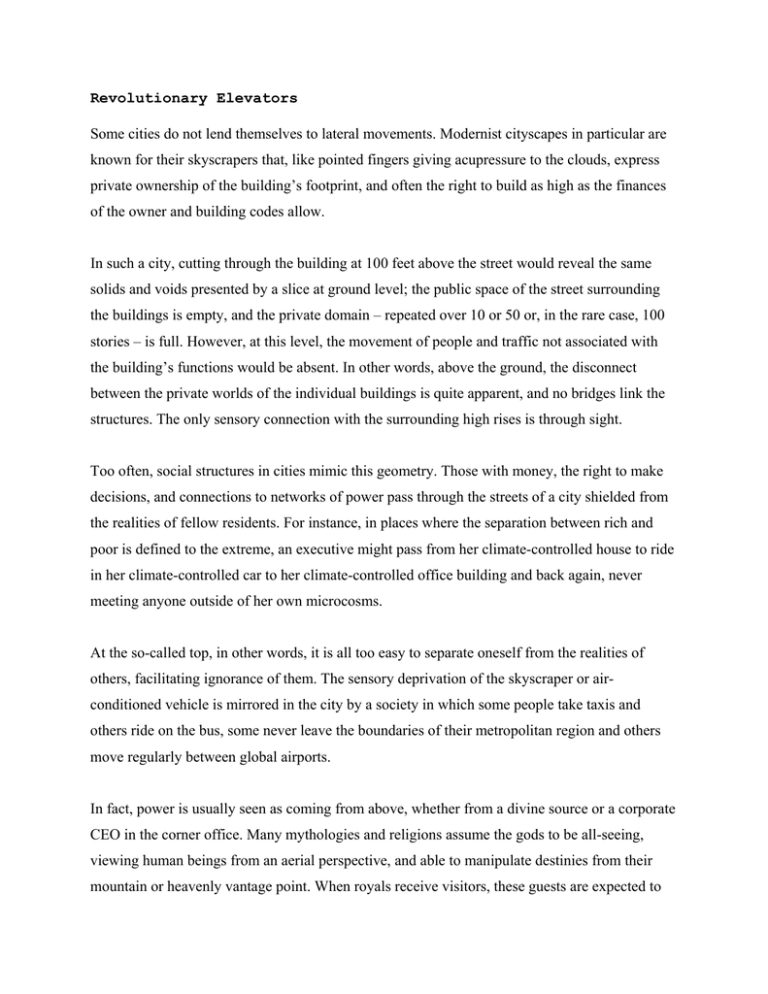Revolutionary Elevators
advertisement

Revolutionary Elevators Some cities do not lend themselves to lateral movements. Modernist cityscapes in particular are known for their skyscrapers that, like pointed fingers giving acupressure to the clouds, express private ownership of the building’s footprint, and often the right to build as high as the finances of the owner and building codes allow. In such a city, cutting through the building at 100 feet above the street would reveal the same solids and voids presented by a slice at ground level; the public space of the street surrounding the buildings is empty, and the private domain – repeated over 10 or 50 or, in the rare case, 100 stories – is full. However, at this level, the movement of people and traffic not associated with the building’s functions would be absent. In other words, above the ground, the disconnect between the private worlds of the individual buildings is quite apparent, and no bridges link the structures. The only sensory connection with the surrounding high rises is through sight. Too often, social structures in cities mimic this geometry. Those with money, the right to make decisions, and connections to networks of power pass through the streets of a city shielded from the realities of fellow residents. For instance, in places where the separation between rich and poor is defined to the extreme, an executive might pass from her climate-controlled house to ride in her climate-controlled car to her climate-controlled office building and back again, never meeting anyone outside of her own microcosms. At the so-called top, in other words, it is all too easy to separate oneself from the realities of others, facilitating ignorance of them. The sensory deprivation of the skyscraper or airconditioned vehicle is mirrored in the city by a society in which some people take taxis and others ride on the bus, some never leave the boundaries of their metropolitan region and others move regularly between global airports. In fact, power is usually seen as coming from above, whether from a divine source or a corporate CEO in the corner office. Many mythologies and religions assume the gods to be all-seeing, viewing human beings from an aerial perspective, and able to manipulate destinies from their mountain or heavenly vantage point. When royals receive visitors, these guests are expected to genuflect, increasing the height differential between throne and floor. Or there are “upper” and “lower” classes, implying that those who preside over the important decisions of our time also reside somewhere in the clouds, over the rest of us. And the social or corporate “ladder” is a metaphorical journey from the depths of nothingness to ascension above the masses. We may ask, particularly in urban contexts, why the contemporary world mirrors supernatural and feudal ones. In addition to discomfort with undemocratic distributions of power, this top-down or bottom-up understanding of the world may actually be outmoded in an increasingly globalized world. Some of the major contemporary forces of change for our cities rely on transnational, lateral structures and not the organization of a clearly defined nation-state or corporate headquarters. The invention of the elevator allowed the luxury of not climbing the stairs, but no longer do we know if the top floor is really the most desirable, even with its rooms with views, when terrorists destroy skyscrapers. We no longer know which way is up. Returning to our imagined city, we pass through the revolving door and through the lobby of a typical high-rise building, its elevator carries us between the floor plates. The repetition of open spaces provides efficient environments to be modified and deployed for various uses. The elevator shaft slices a hole through them, and the elevator obediently follows its regimented path. As we travel upward, our ears may need adjustment, but we are otherwise unaware of the difference between the floors we do not alight on. But can there be an alternative destination? In the children’s book Charlie and the Great Glass Elevator, one special button inside Willy Wonka’s factory elevator allowed it to reject its shaft and to explode through the roof, fly into the sky, and eventually travel through space. We can only hope for such a revolutionary elevator – one that moves beyond shafts, ladders, and separations between people – in our cities. Globalizing forces may disorient and challenge us, but we can employ them in our efforts to make cities with more lateral possibilities and powers.


